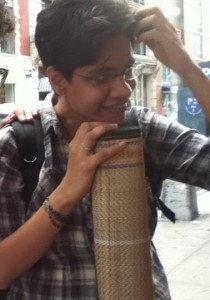Asha Kowtal and Thenmozhi Soundararajan: The Journey towards Liberation
By Sonia J. Cheruvillil
Part 2
****
In 2012, the Haryana district in India witnessed a significant and historic moment in Dalit women’s movement. Organized and led by Dalit women – the Dalit Mahila Garima Yatra (Dalit Women’s Dignity March) traveled to ten districts across the state of Haryana. The Yatra met with survivors, spoke to families and community groups, confronted police and district officials, throughout the journey. They organized awareness programs, street theater, held protests and discussions in villages across Haryana.
As a result of this process, the All Indian Dalit Mahila Adhikar Manch (AIDMAM) decided to launch the Dalit Mahila Swabhiman Yatra (Dalit Women’s Self-Determination March) in 2014 – a month long journey of Dalit activists across multiple states in India. From February to March 2014, the Dalit Mahila Swabhiman Yatra traveled hundreds of kilometers – in Haryana, Utter Pradesh, Bihar, Chattishgarh, Maharashtra, Madhya Pradesh and finally – on March 12, 2014 – arrived at Jantar Mantar in Delhi for a public meeting.
On April 12th, 2014 – Asha Kowtal and Thenmozhi Soundararajan spoke at an event in New York City (organized by the South Asia Solidarity Initiative). Asha Kowtal is the General Secretary of AIDMAM, a national campaign that launched the Yatra. Thenmozhi Soundararajan is a Dalit American activist, filmmaker and organizer. Both traveled across India on this historic tour with hundreds of Dalit women demanding justice and accountability for violence and oppression.
This interview is an edited transcript of a conversation with Asha Kowtal and Thenmozhi Soundararajan where they discuss the Dalit Mahila Swabhiman Yatra, the role of Dalit men within the movement, Savarna feminism, the mass mobilization triggered by Nirbhaya’s gang rape and murder, and finally sex work and caste.
****
SC: Can you talk about the Yatra within the context of the mass mobilization that took place after Nirbhaya’s gang rape and murder in 2012? What did the movement do to Dalit voices?
AK: For us – the December movement – that type of case was not new; and it was not a new discourse. We had been fighting and resisting violence in all forms for a long time. The history of our resistance struggles is highly evolved. For ex., the struggles against ending the Devadasi caste practice; ritual prostitution – this was part of the Dalit movement.
But after Nirbhaya, there was a lot of new thinking, especially after the Justice Verma Committee – that gave more spaces for discussion in civil society. I was in Delhi at the time and every other day, there were consultations, meetings, & discussions. And we could raise the issue of caste-based violence. But the feeling of the people sitting in these meetings was that all (poor) women are Dalits or that all Dalits are oppressed. Very simplistic. The understanding of the multiple forms of discrimination and violence – or that this violence is located within a larger structure of caste oppression – is not understood. People are uncomfortable talking about it. They don’t think caste is an issue or they think we are playing identity politics. It’s not generally welcomed – even a willingness to understand is not there.
There are a few people who are attempting to understand. But then we have the whole question of who speaks for whom? Who leads who? Without that understanding of structures and the thinking behind it; it results in a soft symbolic talk.
SC: One of the narratives of Nirbhaya’s story when people were trying to analyze why this case triggered such a movement – was that “there was no caste” in the story. That Nirbhaya was “an ordinary girl.” Can you respond to this?
TS: It was a decision by the larger feminist movement, by the media to not talk about her caste. It was a very strategic, intentional decision. They talked about her in terms of only class – that she was upwardly mobile, middle class. She was aspirational in all the ways that the middle class wanted to be. But the other piece of the aspirational story was that she was Bahujan. She was OBC.
Caste was always there.
AK: It worked with the group of feminists who came out to the Delhi protests – taking away of the caste narrative works well for that group. These same people would come out to protest against reservations, against the anti-corruption rallies – they could be more easily convinced to come out if caste could be kept away from the discussion. So when it is packaged in this way, that she is casteless – she was a Delhi-based student, aspiring, learning – that packaging works well to mobilize people.
SC: What happened to the national conversation on rape, when you took away caste? What damage did it do?
TS: If there had been a continuum of understanding, if it had been placed within the caste context of sexual violence — the movement could have encompassed all women. Instead, it was the freedom and justice of this one woman. And I think that’s what the Dalit women’s movement contributes to this important national conversation – are we truly free if only a particular class or caste of women are free? No. We cannot stop unless all of us are free. (Towards this goal), we cannot refuse to see that sexual violence is used differently with Dalit women, as a tool to maintain hierarchy and caste.
 AK: We are in full solidarity with every rape victim. What we were saying was that our institutions are based on models of caste and patriarchy. So when they work, they work against all women. It impacts Dalit women more terribly. So unless these institutions are fixed, unless these stop operating on the basis of caste, on the basis of patriarchy, then these institutions won’t actually work for any woman.
AK: We are in full solidarity with every rape victim. What we were saying was that our institutions are based on models of caste and patriarchy. So when they work, they work against all women. It impacts Dalit women more terribly. So unless these institutions are fixed, unless these stop operating on the basis of caste, on the basis of patriarchy, then these institutions won’t actually work for any woman.
SC: Can you talk about points of solidarity and tensions between the (Dalit) sex workers collectives and unions and the larger non-sex workers Dalit movement?
AK: Simply because sex workers are made up of Dalit women, does not mean it is a Dalit movement. How did it come about that all sex workers are Dalit, how did they end up in the brothels? Do you find Jat or Yadav women in these brothels significantly, in large numbers? Is there a politics and a thinking that questions this as a caste practice within the (sex workers) movement?
There are two points I want to make in relation to sex workers’ movements. One is of choice. Within sex workers movements, are there conversations that frame sex work as a caste-based occupation? I find it very problematic to talk about choice without understanding the nexus of exploiters, caste, and class, as well as the history of ritual prostitution and sexual exploitation.
Secondly, there has to be an understanding that upper caste women have both historically and presently – always played a role in exploiting Dalit women. This violence can be in terms of verbal abuse; violence at village water pumps; the treatment of domestic workers and how dominant caste women have built their lives by exploiting these workers. Upper caste women have often played a pro-active role in mob-violence and other forms of violence against us, Dalit women.
TS: There has to be an understanding of the social context of sex workers – not just the social context of being trafficked — but the larger continuum of sexual trafficking through the devadasi caste practices, caste atrocity as well as exploitation across international boundaries. These larger, cultural and caste structures are not addressed (in sex worker unions and collectives).
What you end up finding is a conversation about HIV/AIDS and an upper caste woman talking about the need for increased acceptance of sex work. Caste is not a supported conversation.
AK: In same way that Nirbhaya’s story became caste-less; the labor of sex work has no caste dimensions.
TS: In the West, there’s a very strong conversation around sex work as a choice. But that’s a very different context. When Savarna feminists use white feminist models of understanding gender and sexuality, instead of doing their own work of unpacking their own privilege – then it becomes problematic. There’s a strong need to look to Dalit feminism for models of (Dalit) assertion.
Often times, what happens is that – Savarna feminists paint Dalit women as not being “sex positive.” The conversation of sex work as a choice leads to a sex positive discussion, where the conversation suggests that Dalit women are being prudes or conservative. But this isn’t about moral conservatism. It’s an assertion of what is the ideological model being used and being collaborated with. Is it a subject, is it hierarchal? Starting with the point that caste is enforced through women’s bodies. How women decide to assert their sexuality is part of that self-determination. And allowing that conversation to be whatever it will be. We just need the space to talk, without Savarna mediation.
_____________________________________________________________________________________________
 Sonia J. Cheruvillil is part of the organizing collective of the South Asia Solidarity Initiative (SASI). She lives in (Brooklyn) New York City.
Sonia J. Cheruvillil is part of the organizing collective of the South Asia Solidarity Initiative (SASI). She lives in (Brooklyn) New York City.





Pingback: Dalit Women, Sexual Violence and the Geography of Caste: A Journey towards Liberation - An Interview with Asha Kowtal and Thenmozhi Soundararajan - The Feminist Wire | The Feminist Wire